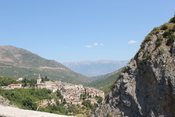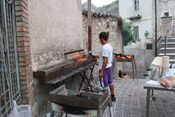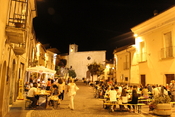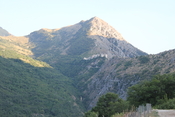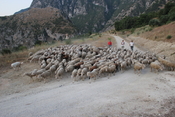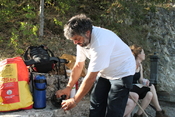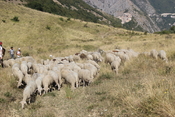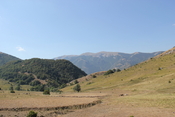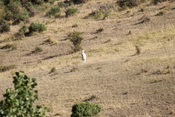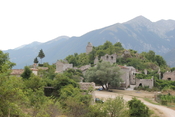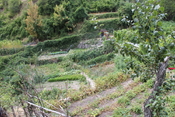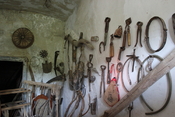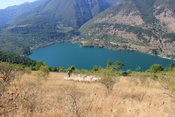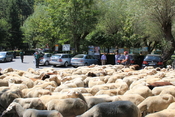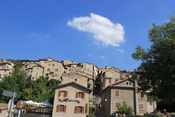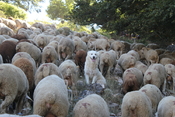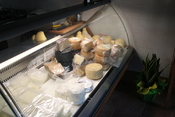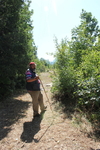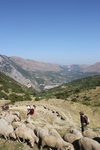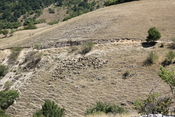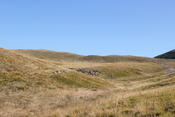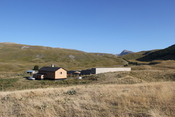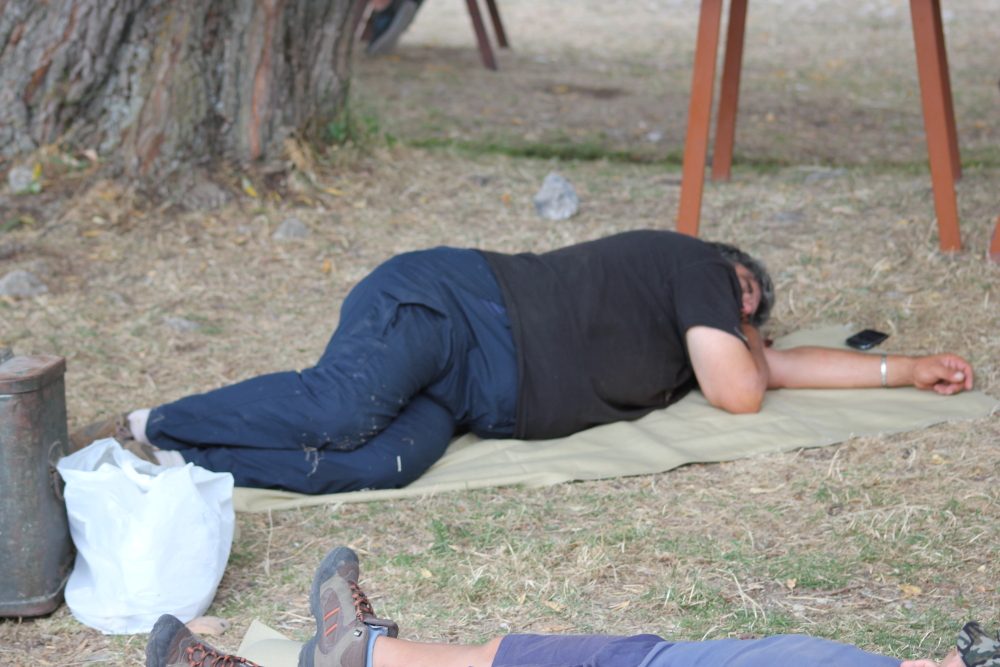I can hardly believe that it’s already been a week since we were with the sheep. Anversa degli Abruzzi is a small town tucked neatly into the Sagittario Valley between the picturesque mountainsides of Abruzzo, Italy. It was our mission to take Nunzio Marcelli’s sheep flock from Anversa to the top of the mountains in Chiarano. It was a ~20 mile, three day journey, full of cured meats, aged cheeses, many gallons of wine, bottles of moonshine grappa, and 300 sheep friends that we will never forget. Click on the thumbnails to see a rough approximation of our route.
 Click each image to enlarge
Click each image to enlarge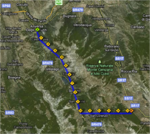 Transhumance RouteTranshumance is the ancient practice of moving ruminant animals to fresh pastures on a seasonal basis. Before feed could be imported to the farm, shepherds would walk with their animals to faraway pastures in order to graze at various times of the year (see our previous transhumance post). Nunzio Marcelli has been practicing this tradition for many years and has recently opened it up to visitors who would like to participate. Check out his site at www.adottaunapecora.com for more information. Even if you can’t go on the transhumance you can still adopt-a-sheep! For the final three days of our honeymoon we decided to join him and his shepherds on the trip, it was a great decision.
Transhumance RouteTranshumance is the ancient practice of moving ruminant animals to fresh pastures on a seasonal basis. Before feed could be imported to the farm, shepherds would walk with their animals to faraway pastures in order to graze at various times of the year (see our previous transhumance post). Nunzio Marcelli has been practicing this tradition for many years and has recently opened it up to visitors who would like to participate. Check out his site at www.adottaunapecora.com for more information. Even if you can’t go on the transhumance you can still adopt-a-sheep! For the final three days of our honeymoon we decided to join him and his shepherds on the trip, it was a great decision.
The night before we set off on transhumance we celebrated with the townspeople of Anversa in a “Sagra degli Gnocchi del Pastore”, which is basically a Shepard style gnocchi-fest in the town piazza. The whole town of 300 was out in full effect. Tables lined the plaza streets, a beer and wine vendor set up shop outside the tobacco store and a highly ironic, teen hair-band fully clad in Iron Maiden shirts and curly long hair played classic hits for the crowd. Unbeknownst to us, the excitement would start right away. Just as we were finishing up our bowls of gnocchi I noticed that the locals were all standing up. Maybe it’s a parade, or maybe the young band members have set something on fire, I thought to myself as I scanned the piazza. Then I noticed what had to have been an 80 year old woman giving the Heimlich to a young, but larger woman. The old woman, having no impact at all, soon gave up. An adult man took over, doing an even poorer job. A local quickly ran to our table and asked if anyone was a doctor. We said no, but Sweetbreads and I quickly jumped to our feet and ran over to help. I jumped behind the woman, stuck my thumb under her ribs and gave a few good heaves. She quickly spat up a few gnocchi projectiles and began breathing again. Phew! What a way to start!
Click images to enlarge. Anversa in the hills, Custom skewer grill, Gnocchi fest in action
After a sleepless night from the Heimlich-induced adrenalin rush (or was it the grappa shots?), we rolled out of bed at 4:45am to eat a quick meal of fresh ricotta and grape jam on bread and meet the shepherds and our pack mules for the trek. Our shepherds were Constantino and Vale (the son of cheesemaker Fiorello). Nunzio and Fiorello would join on and off and bring us provisions (and by provisions I mean wine, meat, bread and cheese) over the ensuing three days. As we descended the hills of Anversa we made our way through the Sagittario Valley, across a stream and through the woods (to the shepherd's house we go!). We then ascended a small mountain and arrived in the town of Castrovalva where locals were accustomed to seeing the sheep pass on their annual route. One seasonal visitor, however, did not appreciate the sheep in his running path and proceeded to scream at Nunzio that the sheep should be transported using livestock trailers and not paraded through the town like the uncivilized days of yore. I guess even the most rural of rural Italy is struggling with the ag vs. development dilemma. Our stop in Castrovalva at about 9am consisted of our first glass of red wine, some fruit and hard rolls with delicious lamb salami. Seemed like an apt second breakfast and we were ready to move.
Click images to enlarge. Castrovalva on the hill, Our flock of 300 sheep, Wine at 9am? You bet
Click images to enlarge. Flock - Castrovalva in background, Flock grazing, Guard dog checking us out
By the end of the day we had made it to the abandoned town of Frattura Vecchia, which means Old Frattura. With our jugs of wine and a giant watermelon cooling off in a nearby watering hole we sat down to eat a late afternoon meal. The town is called Old Frattura because the town of Frattura was destroyed by an earthquake in 1915 and the townspeople decided to build the new town (Frattura Nuova) in a different location, this time with a view of the Lake of Scanno (nice call, in my opinion). However, there are still some goings-on in Frattura Vecchia. Hidden in the hills lies a small home maintained by a long-time resident, Palmerino. Palmerino’s parents' home somewhat survived the earthquake and he uses it as a museum of sorts for the few visitors that pass through each year. He filled the rooms with old farm implements, kitchen tools, and day-to-day stuff from the old times. Palmerino also terraced the nearby hillsides and operates a large "garden" full of fruit trees, tomatoes, beans, chickpeas, peppers, cabbages and a multitude of other produce. He was nice enough to give us a tour and send us home with a bag full of fresh pickings. Palmerino reminded me a lot of my late grandpa George, just as the smell of fresh tomatoes always does.
Click images to enlarge. Frattura Vecchia, Palmerino's terraced garden, Old Italian farm implements
We camped the night in Frattura Nuova (New Frattura) and set out on day two for a hike through Scanno. Scanno is by far the largest town we herded the sheep through (population 2,133), but that number is at least doubled by the number of tourists and visitors on any given day. Scanno is set on the valley's hillside with a grandiose view of the Lago di Scanno below, which is infamous for its heart shape. It was obvious from all the tourist’s faces that they didn't quite as much expect (or appreciate) the movement of a flock of sheep through the middle of their vacation town. We again encountered some disgruntled folks, but in large part all the elders came out to say hi and reminisce about the days when transhumance was something far more common. In fact, the town of Scanno is actually known for being a “woman’s town” because of it's agricultural roots. All of the men would leave for months at a time to go on transhumance and the women would have the run of the place. There is a full history of clothing, jewelry and town traditions built around the concept of transhumance. What fun to be a part of maintaining that tradition. Along the way through town I made friends with an old hydro-electric engineer who came to chat about the days when he was a young adult and his job was to be a “vet” for the ill sheep that passed through town. After a nice conversation he sent me on my way with a bottle of liquore from his home. I loved meeting people in the small, old towns in Italy. After 20 minutes it’s like you’re best friends and they always have great stories to share.
Click images to enlarge. Sheep grazing above Lago di Scanno, Sheep in Scanno!, Scanno homes
In the afternoon we hiked up the hill beyond Scanno and camped 4-5km south of the city at Nunzio’s friend’s place, Valle Scannese di Gregorio. Gregorio is a boisterous old shepherd who joined us for the second day of the transhumance and was happy to feed and water us at the end of the day. Our sheep foraged and slept in one of his paddocks for the night and we happily chomped on Gregorio’s meats and cheeses. Gregorio runs his own flock of sheep and a herd of cows as well. He makes all of his meats and cheeses on-site. We had some beef carpaccio, many tasty salamis and some incredible cheeses. Gregorio and Nunzio have been friends for years and we were especially fond of the cheeses they learned to make while visiting Afghanistani herdsman many years ago. They went to Afghanistan to teach the herdsmen methods of preserving animal milk and came back with a few tricks of their own.
Click images to enlarge. Guard dog with flock, Cheese counter at Gregorio's, Gregorio with staff, View of valley
The morning of the third day we awoke to realize that this was the last true day of our honeymoon. The next day we’d be in Rome, on a plane home to NYC. As sad as it was for our trip to come to an end we were happy to be spending it with our new friends and our huge flock of sheep. This final day of our transhumance would be the day we reached our final destination. The sheep would end up in the beautiful pastures they’d call home for the next four months and our shepherds would similarly find their hut at the top of the mountain where they would live until November. It was a long day of hiking, much of it uphill and through the woods. We walked through giant fields of flowers in the intermittent valleys and stopped with the sheep to graze and drink some water in the afternoon. As usual we had our doses of red wine, grappa and cheese along the way. As we hiked through the forested mountainside we never envisioned where we would end up. The trees seemed never ending. Then it all opened up. At about six in the evening we emerged from the trees to see a rolling expanse of green and golden hills. Now this was a sheep’s paradise! Guard dogs from the hills above came to meet us and our flock. These dogs had been with another group of Nunzio’s sheep since June. All in all there’s about 25 dogs, a mix of guide dogs and guard dogs. Wolves and bears are the primary predators in the region and each year Nunzio’s flock of ~1,200 sheep sustains ~30 or so losses.
Click images to enlarge. Sheep grazing hillside, Final pastures for sheep, Shepherd's house and sheep pens
We ambled up the hill and checked out the shepherd’s digs. A small house with a kitchen and fireplace and a couple rooms. The front yard had some old garden plots, but nothing growing from this year. The living room was full of provisions and much of the wild forages in the surrounding hillsides could be eaten (tons of wild spinach, for instance). Roots of the nearby genziana plant could be made into a potent alcohol, although I don’t think our shepherds were planning on attempting any of that. A few huge concrete block pens sat next to the house. This was where the sheep would be penned at night for protection. Once a bear got in and ate six sheep, but otherwise they had served their purpose over the years. During the days the shepherds would take the sheep from dawn to dusk on long walks through the mountains to graze various pastures and pass the time. It was a beautiful setting and I’d have to loved to spend a full season in those mountains. It might get lonely (and cold!) at times, but it must be an incredible experience.
So that’s the story of transhumance on our honeymoon. I'm having serious withdrawals just thinking about it. Quite an amazing experience and I’d love to do it again one day.
I leave you with a shot of our trusty shepherd and host, Nunzio Marcelli, taking a well-deserved nap. Ciao Nunzio!
We'd love to hear your fun honeymoon or farming-vacation experiences in the comments section below.


